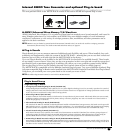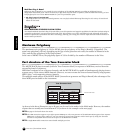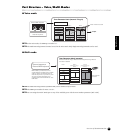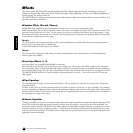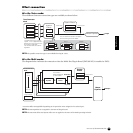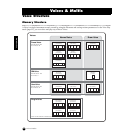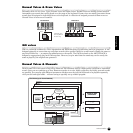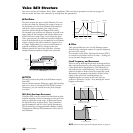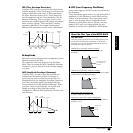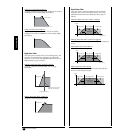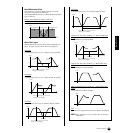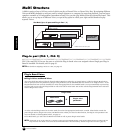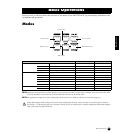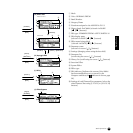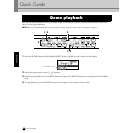
27
Basics Section
Voices & Multis
FEG (Filter Envelope Generator)
Using the FEG, you can control the transition in tone
from the moment a Note On message is received to the
point at which the sound stops. As illustrated below,
the Filter Envelope consists of five Time (transition
speed) parameters and five Level parameters (for the
amount of filtering). When you press a note on the
keyboard, the cutoff frequency will change according to
these envelope settings. This is useful for creating
automatic wah effects, for example. Furthermore,
different FEG parameters can be set for each Element.
● Amplitude
This unit controls the output level (amplitude) of each
Element output from Filter.
The signals are then sent at this level to the Effect
block. Also, by setting the AEG (Amplitude Envelope
Generator), you can control how the volume changes
over time.
AEG (Amplitude Envelope Generator)
Using the AEG, you can control the transition in
volume from the moment a Note On message is
received to the point at which the sound stops. As
illustrated below, the Amplitude Envelope consists of
four Time (transition speed) parameters and three
Level parameters (for the amount of filtering). When
you press a note on the keyboard, the volume will
change according to these envelope settings.
Furthermore, different AEG parameters can be set for
each Element.
● LFO (Low Frequency Oscillator)
As its name suggests, the LFO creates waveforms of a
low frequency.
These waveforms can be used to vary the pitch, filter or
amplitude of each Element to create effects such as
vibrato, wah and tremolo. These waveforms can be
used to vary the pitch, filter or amplitude of each
Element to create effects such as vibrato, wah and
tremolo. LFO can be set independently for each
Element; it can also be set globally for all Elements.
About the Filter Type of the MOTIF-RACK
Low Pass Filter
This only passes signals below the Cutoff frequency. You
can then use the Resonance parameter to add further
character to the sound. The MOTIF-RACK features six
Low Pass filter types as follows.
LPF24D (Lo
w Pass Filter 24dB/oct Digital)
A 4-pole (-24db/oct) dynamic LPF with a strong
Resonance.
LPF24A (Lo
w Pass Filter 24dB/oct Analog)
A 4-pole (-24db/oct) dynamic LPF with a character similar
to those found on analog synthesizers.
LPF18 (Lo
w Pass Filter18dB/oct)
A 3-pole (-18db/oct) dynamic LPF.
LPF18s (Lo
w Pass Filter 18dB/oct Staggered)
A 3-pole (-18db/oct) dynamic LPF, but with a shallower
frequency curve.
0
Release
Level
Attack
Level
Hold Level
Attack
Time
Hold
Time
Decay1
Time
Decay2
Time
Release
Time
Decay1
Level
Decay2
(Sustain) Level
Key off
Time
Cutoff
Frequency
0
Initial
Level
Attack
Time
Decay1
Time
Decay2
Time
Release
Time
Decay1
Level
Decay2
(Sustain) Level
Key off
Time
Level
Resonance
These frequencies
are “passed” by
the filter.
Resonance
LPF18
LPF18s
Resonance



